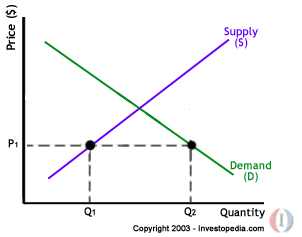The concept of supply and demand is very fundamental in economics especially in the operation of a market economy. Demand essentially entails the quantity of a product or service that will be desired by consumers at a certain time (Colander, 2008, p.132). Supply on the other hand is the quantity that producers in a market are willing to offer. The two, supply and demand are basically influenced y the market prices hence equilibrium.
Other factors that affect the demand level in a market economy include; consumer expectations, incomes, availability of substitutes, prices of complements, technology and seasonal changes among others. Supply levels are influenced by government policies, seasonal changes, production changes and costs, technology, natural disasters just to mention but a few. The aforementioned factors affecting demand and supply are what cause movements and shifts of the demand and supply curves. Depending on the affecting factor at hand, preventable measures have to be put in place so as to maintain the market equilibrium where producers and consumers are comfortable with the price and services or goods.

In the case of the nonprofit theater company the demand exceeds the supply as shown in the graph above. This is because the theater hall can only accommodate 120 people yet the number of people demanding for the tickets is enormous due to the fact that the set actors to perform are of national reputations. In this situation, the fixed factor is the capacity of the theatre hall which cannot e changed within the limited time.
To overcome this problem in the short run I would first suggest that the ticket price is increased by a small percentage so that the demand is reduced to meet the supply. This is because an increase in price will cause the demand curve which had initially shifted to the right because of the quality of the service to now shift towards the left to its initial position where it balanced with the supply quantity. Another decision which could be made in the short-run is that of selling the tickets on a first-come-first-serve service and in this case, they will not e sold out in a month’s advance. Instead, it is advisable that the tickets are sold only a few days before the actual performance.
This way, a larger representation of the consumers will be reached unlike if it is a month earlier where most likely the rich who have cash at hand throughout will benefit while the poor who live from hand to mouth with no or little savings will not have the opportunity to do so. The aim of doing is to make sure that every group in the population is represented in the small number that will get seats in the theatre.
To overcome such a problem in the long-run, the company should think of expanding to hold a larger capacity of people so that there is no scramble for tickets in future. This will ensure that the supply and demand curve at equilibrium point where both the theatre company and the theatre occupants are comfortable with the price and services offered. After the expansion, it is also advisable that the company administration thinks of enrolling permanent members of the theatre company who are issued with cards. Through this they will be able to predict the possible demand hence taking early measures especially concerning ticket prices given the fact that this is a non-profit company.
Reference List
Colander, D. (2008). Microeconomics 7th ed. McGraw-Hill.